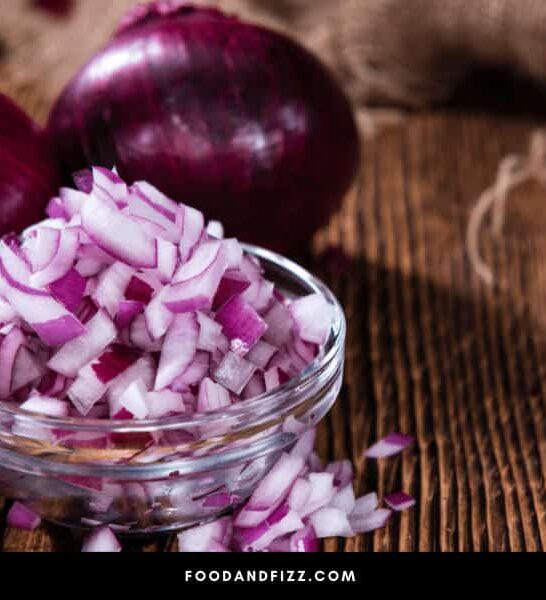When we cook food, several chemical reactions take place that changes the appearance, texture, and taste of food.
Some of these changes we expect and are used to, such as the browning of meat or darkening of green vegetables when heated.
Other color changes though, may understandably throw us off, such as when red onions all of a sudden turn blue. But why does this happen? Why do onions turn blue?
Why Do Onions Turn Blue?
Red onions are part of a family of red or blue-colored vegetables that contain pigments called anthocyanins. Anthocyanins react with acidic and alkaline ingredients in recipes and change the color of the onions in the process. When anthocyanin interacts with acids, the red-purple pigment intensifies, and when cooked with alkaline ingredients, they change the color of onions to a blue or green tinge.
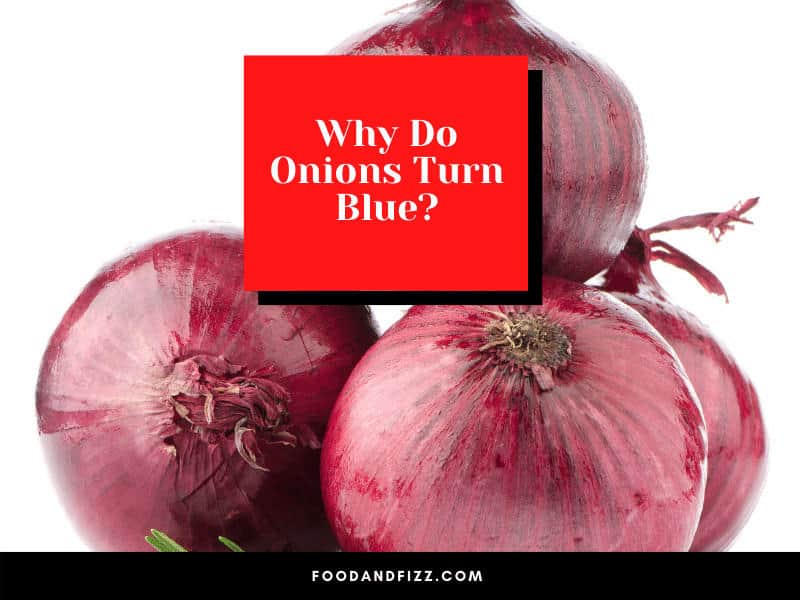
What Are Onions?
Onions are fragrant bulbs that are part of what’s known as the Allium family of vegetables. Garlic, shallots, and leeks are also part of this family.
They are part of what’s called “aromatic vegetables” which are known as the foundation of all flavors in the culinary world. They have a distinct, easily recognizable smell due to the compounds it contains. “What Gives Onions Their Distinctive Smell?” talks about this in detail.
It is cultivated and used all over the world, and forms a flavor base for many different dishes, across all cuisines.
Onions are a versatile ingredient, can be consumed cooked or raw, can be used to flavor dishes, served as toppings, or enjoyed as a side.
They can also be the main dish and main star of the show. The versatility of these little bulbs of flavor has made them an indispensable part of cooking.
Different Types of Onions
As varied as the uses of onions are, so are the types of onions. We’ll look at some of them below.
1. Yellow Onions
Yellow onions, also known as brown onions, are known as the all-purpose onion. They are a bit stronger when consumed raw but they hold up to heat very well and caramelize, roast and saute beautifully. When recipes don’t say what type of onion to use, you can usually safely assume that yellow onions may be used.
2. Red Onions
Red onions, with their vibrant red-purple color, are a beautiful and tasty way to add color to salads and other raw dishes.
They are commonly consumed raw but can hold up to high heat cooking too, like grilling. They are perfect for adding contrast and texture to raw dishes and are also the best choice for pickling.
When cooked with other ingredients, red onions may change the color of food and may change colors themselves, turning either a brighter red or a blue or green shade.
This has to do with pigments in them called anthocyanins, which react with acid or alkaline ingredients that result in a change of color.
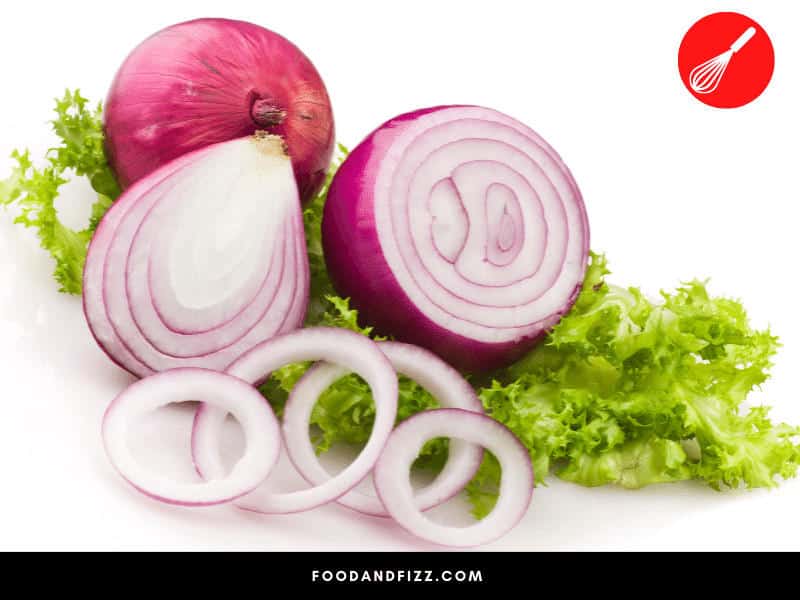
3. White Onions
White onions are milder and sweeter than yellow or red onions, and because of this, can be served raw, too. They might be more preferred by people who find red onions too strong on their salads or burgers.
4. Sweet Onions
As the name implies, they are sweeter than all of the onions we’ve met so far, which make them perfect for caramelizing. They break down quite easily so it’s probably not a good idea to use them as you would a yellow onion, meaning they might not hold up to longer cooking times.
They are perfect served raw and perfect for making onion rings. Sweet onions are classified according to the region where they are grown, with the most well-known of them being the Vidalia onion in Georgia.
Sweet onions also spoil faster than yellow, red or white onions, and are best stored in the fridge to prolong shelf life.
5. Shallots
Shallots also have a light purple flesh but are lighter compared to red onions. Flavor-wise they are described as having a milder, sweeter flavor compared to other onions but with the sharpness, bite, and flavor of garlic.
They are used a lot in French and Asian cuisine and can be substituted for yellow, white, or red onions in recipes.
6. Green Onions or Scallions
Scallions or green onions are fresh, young onions characterized by a white bottom and green leafy tops.
The white part of the green onion has the same onion taste as its other siblings, albeit milder and sweeter in comparison. The green leafy tops, on the other hand, are herbier in taste and texture.
Green onions can be used to flavor dishes in cooking or used raw, chopped up to sprinkle over a variety of dishes. They don’t typically need to be measured when adding to dishes, but in case you need to be precise about it, “How Much Is One Scallion?” can help you quantify the amount for use in recipes.
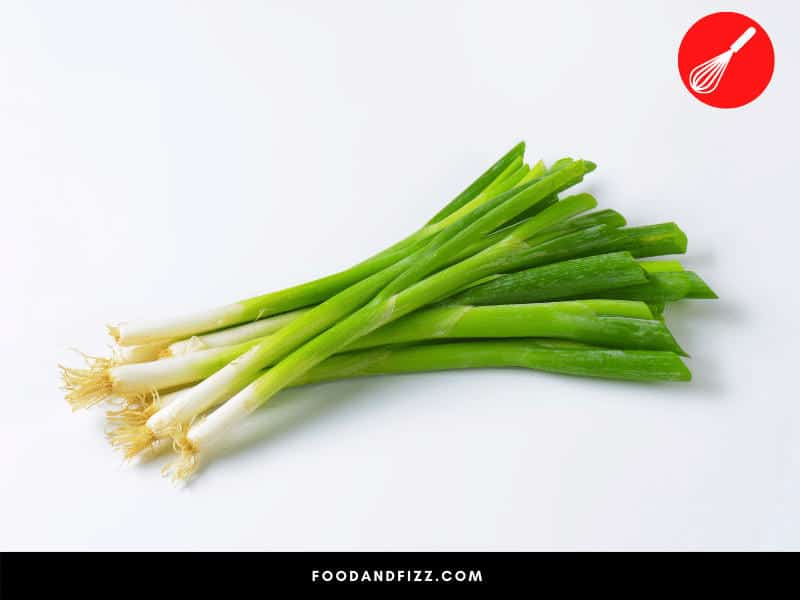
7. Spring Onions
Spring onions are technically not the same as scallions or green onions, although they may look similar and may also be similarly used.
Spring onions are actually young white, yellow or red onion bulbs that are harvested early to give space for other bulbs to grow.
They are a little bit spicier compared to green onions or scallions when raw, but turn sweet when cooked. They have a short harvesting season, and are perfect for grilling, roasting and braising.
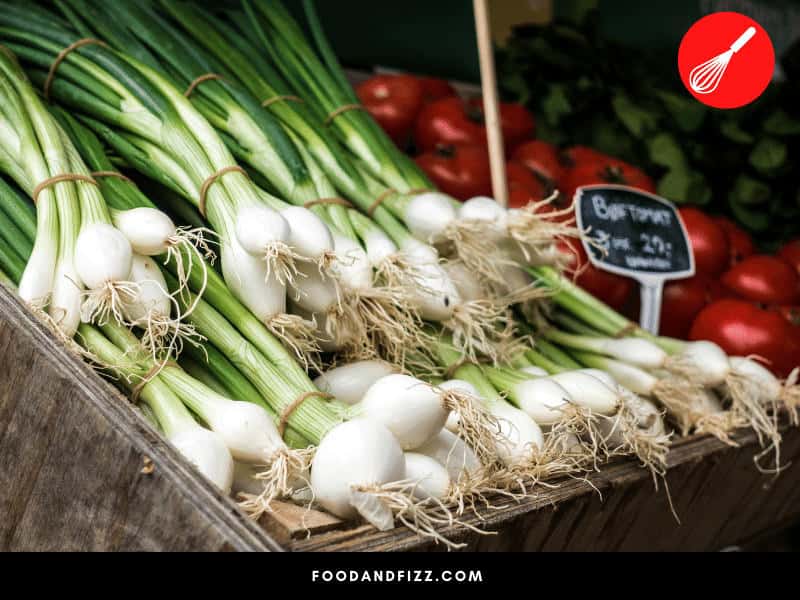
Why Do Onions Turn Blue?
In the culinary world, the color of food, both prior to and after cooking, is a highly prized thing. The right color indicates freshness, proper preparation, and proper presentation of food.
For the one who will eat it, what you see on your plate is an important part of the act of eating itself. Even before tasting the food, your eyes are already telling you whether it’s going to be good or not.
Because of this then, it can be a little disconcerting to see unwelcome colors in our food that we are not used to, especially if the resulting dish ends up looking like something out of a make-believe world.
Blue or green onions are one of those mysterious things that tend to throw us off. You start off with a beautiful piece of red onion, chop it up and add it to your recipe, only to find out later on that your eggs have turned blue or green, and now you’re kind of not sure that you want to eat it anymore.
What happened?
It’s All Because of Anthocyanins
Red onions in particular are rich in pigments called anthocyanins. Anthocyanins are found in fruits and vegetables with a rich red, purple or blue hue, such as red cabbage, berries, grapes, and red onions.
Anthocyanins are a type of antioxidant that have anti-inflammatory and disease-fighting benefits. They are sensitive to light, temperature, and acidity levels in the environment.
The pH Scale
The pH scale determines how acidic something is. A value below the neutral value of 7 is considered acidic, while anything over this value is considered alkaline.
If you paid attention to chemistry class in school, you would know of the litmus paper test. In a litmus paper test, anything acidic will turn the litmus paper red, while anything alkaline will turn the litmus paper blue.
This is a helpful image when we think of our red onions and how an acidic or alkaline ingredient influences their color.
Red onions are particularly acidic, so putting them in an acidic environment or cooking it with acidic ingredients like vinegar, will intensify their red color.
On the other hand, cooking them with alkaline ingredients, for example, egg whites will change their color to a blue or green hue.
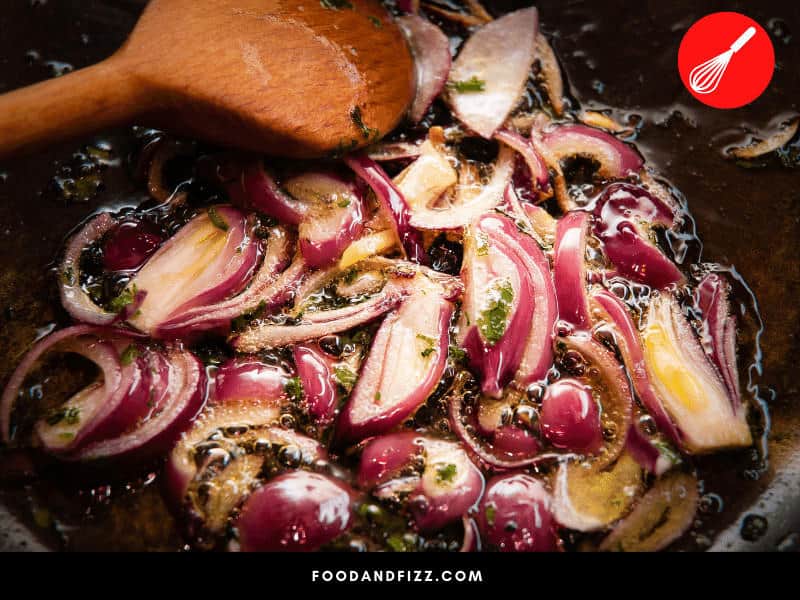
Are Blue Onions Safe to Eat?
Blue onions are a natural occurrence in cooking due to natural chemical reactions.
While not exactly appetizing, they are safe to eat as long as they do not manifest any other signs of food spoilage such as an off, slimy texture, off smell, and off taste.
Conclusion to Why Do Onions Turn Blue
In cooking, there are a lot of chemical reactions that take place, and while some are expected reactions such as when food browns or when green vegetables turn a duller green when cooked, other chemical reactions, like blue onions, are a more curious thing.
Naturally-occurring pigments and enzymes in food react with each other and cause texture and color changes all the time, and onions are no different. The anthocyanins in red onions in particular are responsible for their marked color changes.
As long as your dish is properly cooked, stored, and handled, it will be safe for you to eat. While the color may not be as appetizing, they are probably still as good as red onions.
And also, who knows, where your blue onions can take you. You might just be the person who can make blue onions the next big culinary thing.
Frequently Asked Questions to Why Do Onions Turn Blue
Is It Safe to Eat Onions That Have Turned Blue?
It is normal for onions, especially red onions, to change in color when cooked with other food as their natural pigments react to the acid or alkaline environment of the dish. While they may not be that appetizing, they are safe to eat, provided that no other evidence of food spoilage is occurring.
Why Do Onions Turn Green When I Cook Eggs?
Eggs, especially the whites, have a pH level of 7.6-9.5, making it an alkaline environment for the onions. Anthocyanins, the pigments in red onion in particular, react with acidic or alkaline ingredients and causes the color of your onions (and eggs) to change. Acidic ingredients cause their red-purple color to brighten and intensify, while exposure to alkaline ingredients – like eggs—will cause it to turn blue or green.
Can Blue Onions Turn Red Again?
You can try squeezing some acid on your blue onions, like vinegar or lemon juice. In most cases, it can turn back to its red color again.

